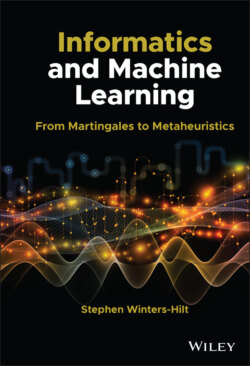Читать книгу Informatics and Machine Learning - Stephen Winters-Hilt - Страница 20
1.7 Classification and Clustering
ОглавлениеSVMs can be used for classification and clustering (to be described in detail in Chapter 10), as well as aiding with signal analysis and pattern recognition on stochastic sequential data. The signal processing material described next, and in detail later, mainly draw from prior journal publications [159–189]. Analysis tools for stochastic sequential data have broad‐ranging application by making any device producing a sequence of measurements more sensitive, or “smarter,” by efficient learning of measured signal/pattern characteristics. The SVM and HMM/SVM application areas described in this book include cheminformatics, biophysics, and bioinformatics. The cheminformatics application examples pertain to channel current analysis on the alpha‐hemolysin nanopore detector (Chapter 14).
The biophysics and “information flows” associated with the nanopore transduction detector (NTD) in Chapter 14 are analyzed using a generalized set of HMM and SVM‐based tools, as well as ad hoc FSAs‐based methods, and a collection of distributed genetic algorithm methods for tuning and selection. Used with a nanopore detector, the channel current cheminformatics (CCC) for the stationary signal channel blockades (with “stationary statistics”) enables a method for a highly sensitive nanopore detector for single molecule biophysical analysis.
The SVM implementations described involve SVM algorithmic variants, kernel variants, and chunking variants; as well as SVM classification tuning metaheuristics; and SVM clustering metaheuristics. The SVM tuning metaheuristics typically enable use of the SVM’s confidence parameter to bootstrap from a strong classification engine to a strong clustering engine via use of label changes, and repeated SVM training processes with the new label information obtained.
SVM Methods and Systems are given in Chapter 10 for classification, clustering, and SSA in general, with a broad range of applications:
sequential‐structure identification
pattern recognition
knowledge discovery
bioinformatics
nanopore detector cheminformatics
computational engineering with information flows
“SSA” Architectures favoring Deep Learning (see next section)
SVM binary discrimination outperforms other classification methods with or without dropping weak data (while many other methods cannot even identify weak data).
